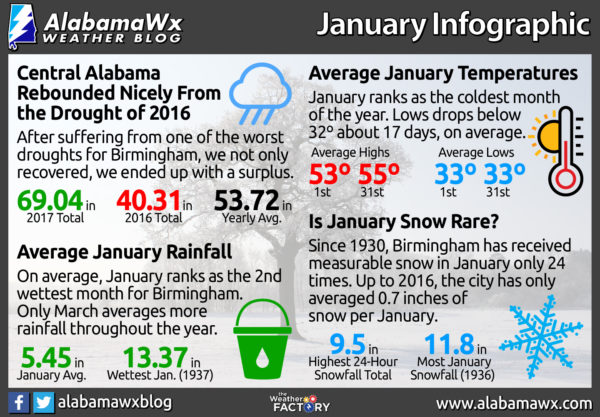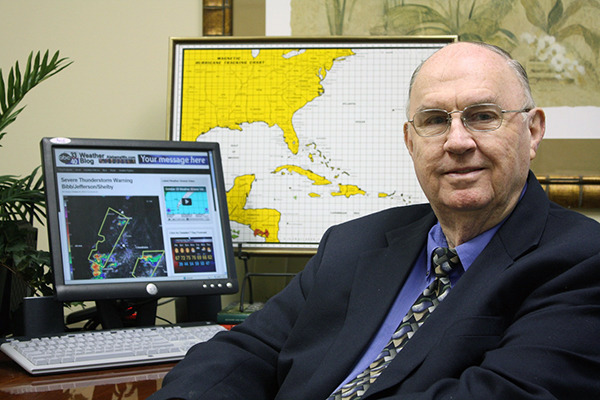Happy New Year! Birmingham’s January Weather Infographic
Welcome to a new year, and to what usually ranks as the coldest month on the calendar for the city of Birmingham. The average high for the entire month of January is 52.8 degrees, while the average low is 32.3 degrees. The month starts off on New Year’s Day with the average high at 53 degrees, and the average low at 33 degrees. By the time you reach the 31st, the average high has only risen to 55 degrees, while the average low dropped during the month and has made it back up to 33 degrees.
January represents the depths of winter in Central Alabama. The days are growing longer now as we have passed the Winter solstice, but you can hardly tell it in the month’s temperatures. The coldest low temperature ever recorded for the city of Birmingham happened on January 21st, 1985 when the mercury dropped to -6 degrees. 1940 is ranked number 1 as the coldest average low temperature for the entire month, at 21.5 degrees.
Surprisingly, it can get very warm in January as well. Back on January 10th, 1949, the thermometer topped out at an amazing 81 degrees. 1950 is ranked number 1 as the warmest average high temperature for the entire month, at 66.6 degrees.
January is ranked as the second wettest month for the Magic City, with March being the only month averaging more rainfall. That is some very encouraging news considering that the city of Birmingham is still classified in an exceptional drought by the U.S. Drought Monitor. On average, Birmingham generally receives 5.45 inches of rain throughout the month, and rain usually falls in the city on 11 days of the month. The wettest month on record for Birmingham was recorded in 1937 when an astounding 13.37 inches of rain fell throughout January. The driest January on record was in 1981 when only 1.09 inches fell.
Snowfall in the city of Birmingham is rare compared to most of the other major cities throughout the United States. Since 1930 (a total of 86 years), measurable snow has fallen in January in the Magic City a grand total of 24 times. During that span, Birmingham has only averaged 0.70 inches of snow in January for each year. The highest recorded snowfall in a 24-hour period during the month of January was 9.5 inches back in 1940, while the most January snowfall fell back in 1936 at 11.80 inches.
January can also be called the gloomiest month of the year, even though most see the month as “a new beginning” over the previous year. January ranks number 1 as the cloudiest month, with the skies being cloudy 48% of the time. It is also considered the foggiest month, with dense fog reported on an average of 1.3 days.
Finally, 2017 ended for the city of Birmingham with recovering from an exceptional drought to having a surplus of 15.32 in. The Magic City tallied 69.04 inches of rain for the year, 28.73 inches more than the 2016 total of 40.31 inches. The yearly average for the city is 53.72 inches, and we were able to easily surpass that number thanks in part to a few tropical systems moving through.
Category: Hodgepodge

















